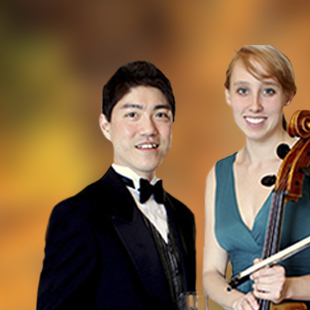S&R Foundation presents Char Prescott and Ryo Yanagitani in Review
Char Prescott, cello; Ryo Yanagitani, piano The Kennedy Center – Millennium Stage, Washington, DC September 12, 2014
The Kennedy Center’s Millennium Stage has earned the remarkable record of having presented a free concert every afternoon at 6pm, 365 days a year (possibly minus a snow day or two), for more than fifteen years. The concerts cover an enormous range of music and dance genres and I must say, if they’ve all been as good as Friday afternoon’s cello and piano duo, Char Prescott and Ryo Yanagitani, then as a New Yorker I’ve really been missing something.
The concert was sponsored by the S&R Foundation, a Washington, DC based charity that is the philanthropic arm of two very unusual individuals, Drs. Sachiko Kuno and Ryuji Ueno, a pair of biochemists who have plowed profits from their highly successful pharmaceutical patents into supporting the arts. They have created an artist-in-residence program along with a concert series at Everymay, the grand Federal-Era estate in Georgetown that they purchased and renovated in 2011, and a kind of entrepreneurship academy at Halcyon House, another historic home they own nearby. The glorious sounding 19th century Italian cello played by Char Prescott is on loan to her from the pair as well.
Ms. Prescott and Mr. Yanagitani opened their program with the second of the three Sonatas for Viola da Gamba — in D Major, BWV 1028 — by J. S. Bach. Gambas are not too commonly found these days, so performances tend to take place on the cello, either with the original harpsichord as accompanying instrument or, in this case, piano. The use of a modern piano can create balance problems, but in pianist Ryo Yanagitani’s hands, the complex interweaving of contrapuntal lines emerged cleanly and without overmatching his partner. The phrasing and dynamics in the duo’s performance tilted a little towards the romantic for my taste, but that’s a quibble. The sinuous interplay of the musical lines in this work makes a good case for some leeway in articulation, so I don’t really blame them for indulging a little. The result was an enchanting reading.
Written in 1886, during a happy and productive summer Johannes Brahms spent in the dramatic lake and mountain scenery of Thun, Switzerland, the Sonata No. 2 for Piano and Cello in F Major, Op. 99 reflects his sunny state of mind. His exuberant score provides plenty of opportunities for virtuoso playing to both performers, particularly in the monumentally difficult piano part, perhaps why the piano is named first in the title. There are generally two styles of performances in this piece: one in which the players hurl themselves at it full throttle in the most dramatic way, and the second which prizes charm and elegance over punch. Prescott and Yanagitani chose the second way, and theirs was a reading that let the honey gold tone of Ms. Prescott’s cello shine through. Mr. Yanagitani demonstrated a control of the thickly written piano part from the sometimes hushed, sometimes brilliant tremolos of the first movement to the whirling triplet chords of the scherzo to the sun-streaked finale that was really impressive.
Béla Bartók’s Six Romanian Folk Dances written in 1915 for piano solo and played in an arrangement for cello and piano closed the program. Here Ms. Prescott got to show off her command of the instrument’s sonic possibilities and, as was the case throughout the afternoon, Mr. Yanagitani provided just the right support. These two artists have clearly played together long enough to completely internalize this repertoire, and their absolute security and deep knowledge of the music communicates real pleasure to their audience. I was certainly happy to have been there.

